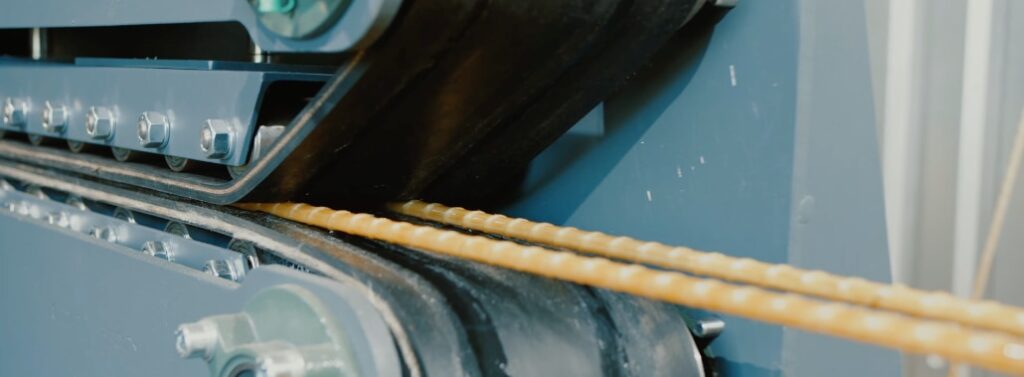हाल के वर्षों में, कंपोजिट रेबार, विशेष रूप से ग्लास फाइबर प्रबलित पॉलिमर (GFRP) रेबार, निर्माण उद्योग में लोकप्रिय हो गया है। यह इसके बेहतर गुणों के कारण है, जैसे कि हल्का वजन, संक्षारण प्रतिरोधी और अत्यधिक टिकाऊ होना। लेकिन उत्पादन लागत के मामले में इस तरह के रेबार का उत्पादन कितना लाभदायक है? आइए इसे विशिष्ट उदाहरणों के साथ समझें।
चाबी छीनना
- टीजीएफआरपी रिबार का मुख्य लाभ इसकी आर्थिक दक्षता में निहित है।
- 10 मिमी व्यास वाले एक मीटर जीएफआरपी रिबार की उत्पादन लागत लगभग tely है $0.152.
- कम्पोजिट-टेक मशीनें 10,000 रैखिक मीटर तक उत्पादन कर सकती हैं 8 घंटे की शिफ्ट के दौरान, न्यूनतम बिजली खपत के साथ - केवल 20 किलोवाट प्रति घंटा।
- एफआरपी रिबार पर स्विच करने के परिणामस्वरूप हो सकता है 300% तक की लागत बचत पारंपरिक स्टील सरिया की तुलना में।

फाइबरग्लास रीबार क्या है??
जीएफआरपी रीबार में एपॉक्सी राल से युक्त ग्लास फाइबर स्ट्रैंड से बनी छड़ें होती हैं। इस सामग्री का निर्माण में व्यापक रूप से उपयोग किया जाता है क्योंकि यह पारंपरिक स्टील रीबार की तुलना में हल्का, मजबूत और अधिक टिकाऊ होता है। हालाँकि, इसका मुख्य लाभ इसकी आर्थिक दक्षता में निहित है।
जीएफआरपी रीबार उत्पादन की लागत
जीएफआरपी रिबार के उत्पादन की लागत को समझने के लिए, आइए 10 मिमी व्यास वाले रिबार को उदाहरण के रूप में लें। ऐसे रिबार के एक रैखिक मीटर का वजन 150 ग्राम होता है।
जीएफआरपी रिबार की संरचना:
- 20% – इपॉक्सी रेज़िन
- 80% – ग्लास फाइबर रोविंग
कच्चे माल की लागत:
- एपॉक्सी रेज़िन: $3 प्रति किलोग्राम
- ग्लास फाइबर रोविंग: $0.5 प्रति किलोग्राम
अब, आइए एक मीटर सरिया बनाने के लिए आवश्यक कच्चे माल की मात्रा और उसकी लागत की गणना करें:
एपॉक्सी रेजि़न:
- 150 ग्राम का 20% = 30 ग्राम
- प्रति मीटर लागत: 30 ग्राम×3 USD/किलोग्राम=0.09 USD30 \, \text{g} \times 3 \, \text{USD/किलोग्राम} = 0.09 \, \text{USD}30 ग्राम×3USD/किलोग्राम=0.09USD
ग्लास फाइबर रोविंग:
- 150 ग्राम का 80% = 120 ग्राम
- प्रति मीटर लागत: 120 ग्राम×0.5 USD/किलोग्राम=0.06 USD120 \, \text{g} \times 0.5 \, \text{USD/किलोग्राम} = 0.06 \, \text{USD}120 ग्राम×0.5USD/किलोग्राम=0.06USD
इस प्रकार, 10 मिमी जीएफआरपी रिबार के एक रैखिक मीटर के उत्पादन के लिए कच्चे माल की लागत है:
कच्चे माल की लागत=0.09 USD+0.06 USD=0.15 USD\text{कच्चे माल की लागत} = 0.09 \, \text{USD} + 0.06 \, \text{USD} = 0.15 \,
\text{USD}कच्चे माल की लागत=0.09USD+0.06USD=0.15USD
उत्पादन व्यय
उत्पादन लागत की गणना करते समय, न केवल कच्चे माल की लागत बल्कि बिजली की लागत और उपकरण मूल्यह्रास पर भी विचार करना महत्वपूर्ण है। आइए कम्पोजिट-टेक उपकरण का उपयोग करके एक उदाहरण देखें, जो बाजार में सबसे अधिक उत्पादक और कुशल है।
कम्पोजिट-टेक उपकरण का प्रदर्शन:
- उत्पादन क्षमता: प्रति शिफ्ट (8 घंटे) 10 मिमी जीएफआरपी रिबार के 10,000 रैखिक मीटर तक।
- बिजली की खपत: 20 किलोवाट प्रति घंटा.
आइये एक शिफ्ट के लिए बिजली की लागत की गणना करें:
प्रति शिफ्ट ऊर्जा खपत=20 kW/h×8 h=160 kW\text{प्रति शिफ्ट ऊर्जा खपत} = 20 \, \text{kW/h} \times 8 \, \text{h} = 160 \, \text{kW}प्रति शिफ्ट ऊर्जा खपत=20kW/h×8 h=160kW
प्रति किलोवाट $0.1 की औसत बिजली लागत मानते हुए, एक शिफ्ट के लिए बिजली की लागत होगी:
160 kW×0.1 USD/kW=16 USD160 \, \text{kW} \times 0.1 \, \text{USD/kW} = 16 \, \text{USD}160kW×0.1USD/kW=16USD
अब, प्रति मीटर रिबार की लागत की गणना करने के लिए, हम बिजली की लागत को उत्पादित कुल मीटरों की संख्या से विभाजित करते हैं:
प्रति मीटर बिजली की कीमत=16 USD10,000 m=0.0016 USD\text{प्रति मीटर बिजली की कीमत} = \frac{16 \, \text{USD}}{10,000 \, \text{m}} = 0.0016 \, \text{USD}प्रति मीटर बिजली की कीमत=10,000m16USD=0.0016USD
जीएफआरपी रीबार की प्रति मीटर कुल उत्पादन लागत
अब, आइए सभी लागतों को जोड़ दें:
- कच्चे माल की लागत: 0.15 अमरीकी डॉलर
- बिजली की लागत: 0.0016 अमरीकी डॉलर
इस प्रकार, जीएफआरपी रिबार के एक रैखिक मीटर की कुल उत्पादन लागत है:
0.15 USD+0.0016 USD=0.1516 USD0.15 \, \text{USD} + 0.0016 \, \text{USD} = 0.1516 \, \text{USD}0.15USD+0.0016USD=0.1516USD
इसलिए, 10 मिमी व्यास वाले एक मीटर जीएफआरपी रिबार की उत्पादन लागत लगभग tely है 0.152 अमरीकी डॉलर.
कम्पोजिट-टेक उपकरण के लाभ
Composite-Tech ऐसे उपकरण प्रदान करता है जो न्यूनतम ऊर्जा खपत के साथ अधिकतम उत्पादकता की अनुमति देता है। कम्पोजिट-टेक मशीनें न्यूनतम बिजली खपत के साथ प्रति 8 घंटे की शिफ्ट में 10,000 रैखिक मीटर तक रिबार का उत्पादन कर सकती हैं - केवल 20 किलोवाट प्रति घंटा। यह अन्य बाजार प्रतिस्पर्धियों की तुलना में 30-40% अधिक कुशल है। इसके अलावा, ऐसी मशीनों का उपयोग करने से मूल्यह्रास और परिचालन लागत कम हो जाती है, जिससे अंतिम उत्पाद की लागत और कम हो जाती है।

जीएफआरपी और स्टील रीबार की लागत की तुलना
स्टील रीबार की उत्पादन लागत काफी अधिक होती है। उदाहरण के लिए, 10 मिमी व्यास वाले स्टील रीबार की लागत लगभग 0.5 USD प्रति मीटर है। यह GFRP रीबार की लागत से तीन गुना अधिक महंगा है। कम्पोजिट-टेक उपकरण.
इसके अलावा, GFRP रीबार में संक्षारण प्रतिरोध जैसे लाभ हैं, जो संरचनाओं के जीवनकाल को महत्वपूर्ण रूप से बढ़ाता है और रखरखाव और मरम्मत की लागत को कम करता है। इस प्रकार, FRP रीबार पर स्विच करने से 10 ... 300% स्टील रीबर का उपयोग करने की तुलना में।
बारे में और सीखो एफआरपी रीबार बनाम स्टील रीबार
निष्कर्ष
कम्पोजिट-टेक के आधुनिक उपकरणों का उपयोग करके जीएफआरपी रिबार का उत्पादन करना आर्थिक रूप से व्यवहार्य समाधान है, जो कम उत्पादन लागत और उच्च उत्पादकता प्रदान करता है। एफआरपी रीबार यह न केवल उत्पादन में सस्ता है, बल्कि इसके अनेक लाभ भी हैं, जो इसे आधुनिक निर्माण परियोजनाओं के लिए आदर्श विकल्प बनाते हैं।

बारे में और सीखो दुनिया भर के ग्राहक GFRP रीबार उत्पादन के लिए उपकरणों के सबसे विश्वसनीय आपूर्तिकर्ता के रूप में कम्पोजिट-टेक को क्यों चुनते हैं


हम दिल्ली, भारत में प्लांट स्थापित करना चाहते हैं। क्या आप हमारी मदद करेंगे?
GFRP उत्पादन लाइन के लिए प्रौद्योगिकी खरीदने की सोच रहे हैं। कृपया मूल्य अनुमान साझा करें